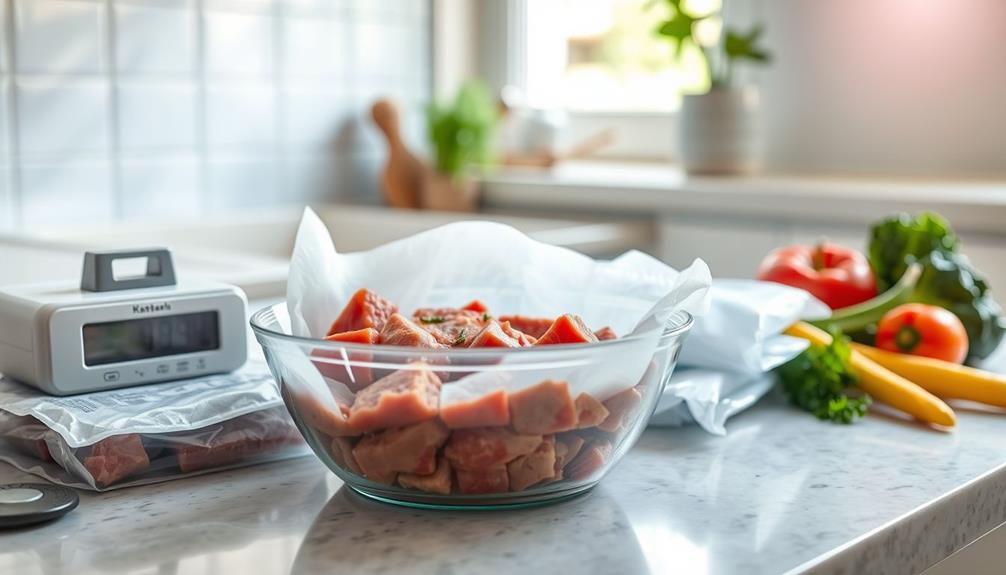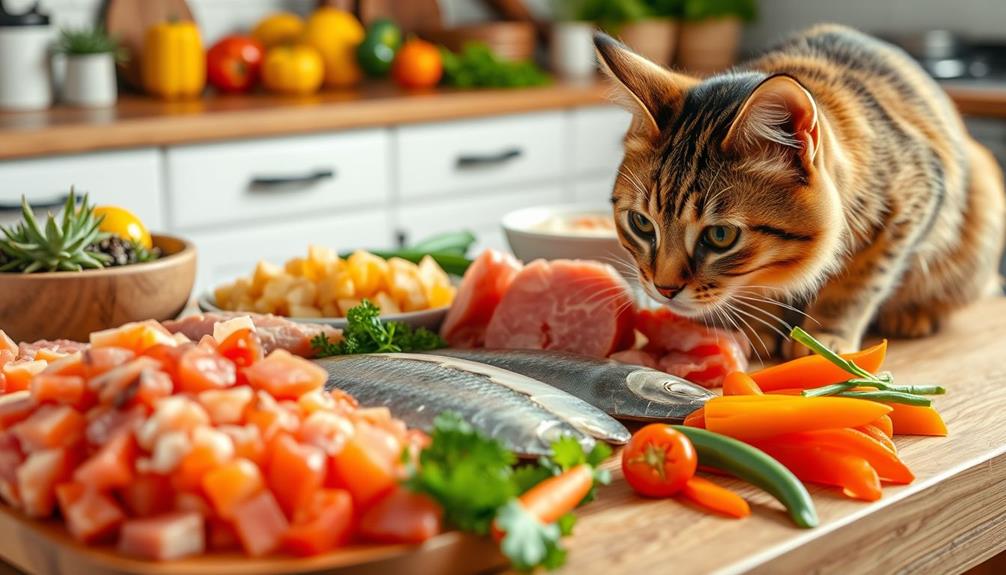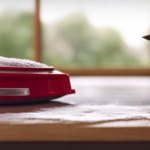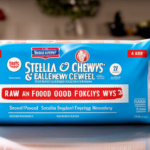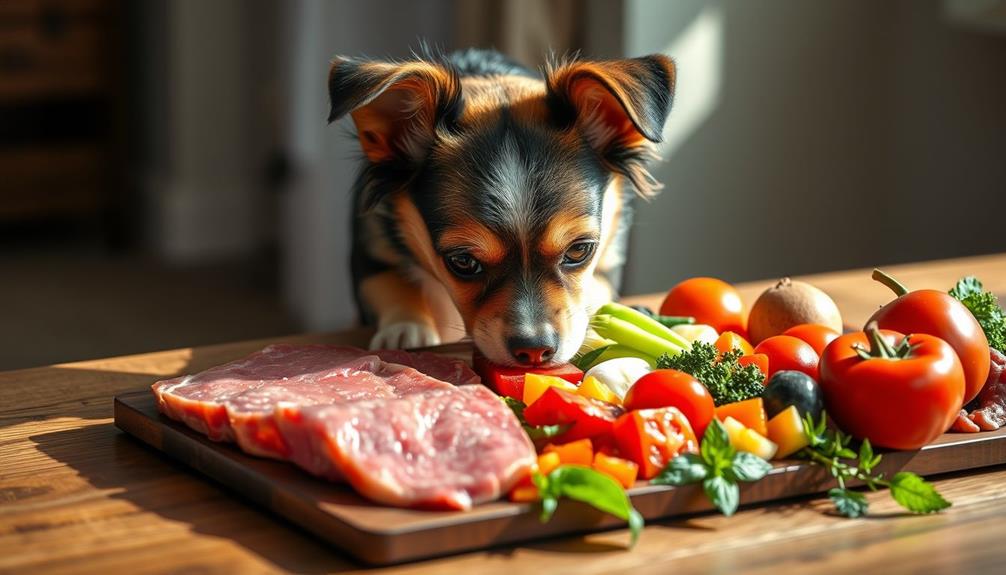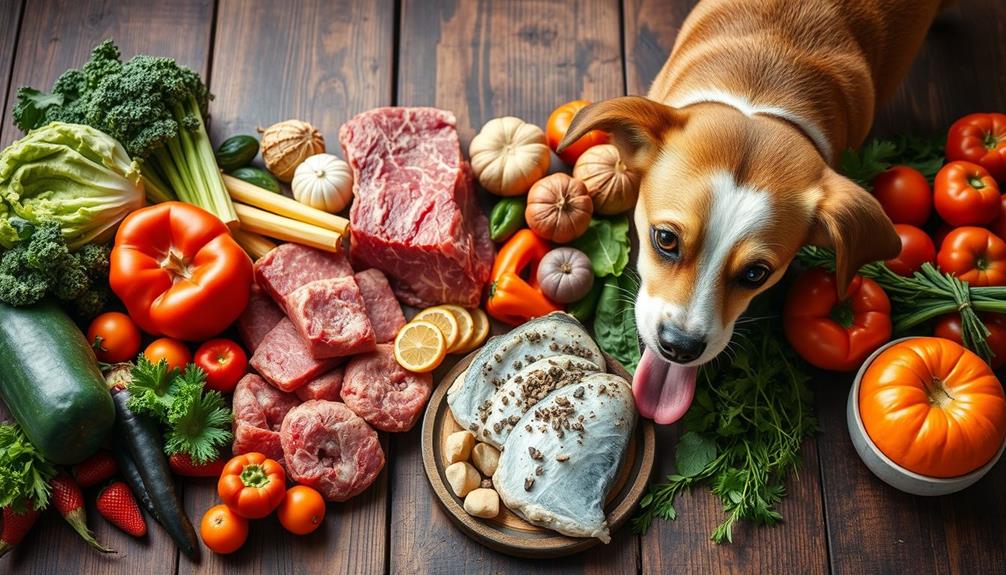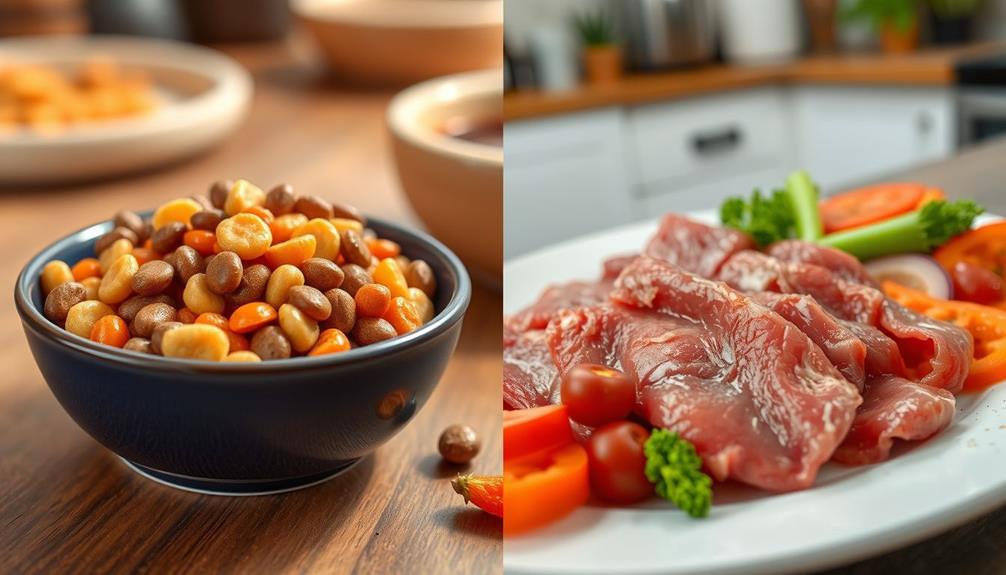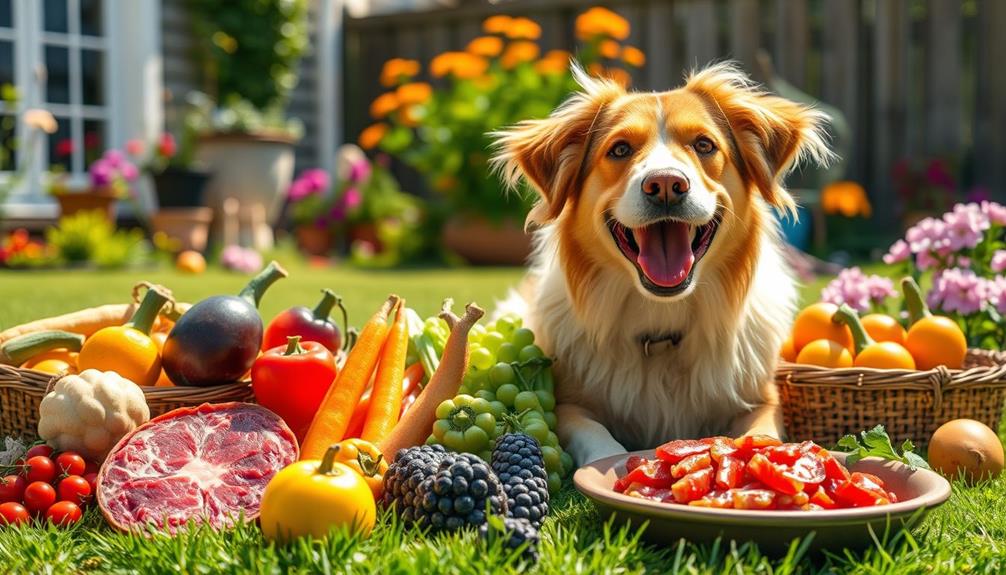To defrost dog raw food properly, use safe methods like refrigerator thawing or cold water thawing. Place the food in the fridge overnight for 12 to 24 hours. If you're in a hurry, seal it in a leak-proof bag and submerge it in cold water, changing the water every 20-30 minutes. Avoid countertop thawing since it risks bacterial growth. Microwaving is also a no-go as it can cause uneven thawing and nutrient loss. Always handle raw food with care to prevent contamination. You'll find even more tips to guarantee your pet's meals are safe and beneficial.
Key Takeaways
- Thaw raw dog food in the fridge overnight (12-24 hours) to ensure safe and even thawing without bacterial growth.
- Use the cold water thawing technique by sealing food in a leak-proof bag and changing the water every 20-30 minutes.
- Avoid countertop thawing, as it can lead to uneven temperatures and bacterial growth in the danger zone.
- Do not microwave raw dog food, as it can cause uneven thawing and reduce nutritional value, while increasing bacteria risks.
- Serve thawed food immediately and do not refreeze it, maintaining hygiene practices to prevent cross-contamination.
Best Method for Defrosting
When it comes to defrosting dog raw food, the best method is to place it in the fridge overnight. This approach allows the food to gradually thaw, guaranteeing the thawing process occurs safely while minimizing the risk of spoilage and harmful bacteria growth. Proper handling of raw food is vital, as it can prevent health issues for your dog, similar to hamster health signs.
Typically, a 500g container will take about 10-12 hours to fully defrost in the refrigerator.
To prioritize food safety, store the raw food on the bottom shelf in a leak-proof container. This prevents cross-contamination with other foods, which is essential when handling raw meat.
If you find yourself in need of a quicker method, you can submerge the sealed food in cold water, changing the water every 20 minutes. This can defrost your food in just a few hours.
However, avoid using the microwave for defrosting as it can lead to uneven thawing and may partially cook the meat, compromising its nutritional value.
Risks of Countertop Thawing
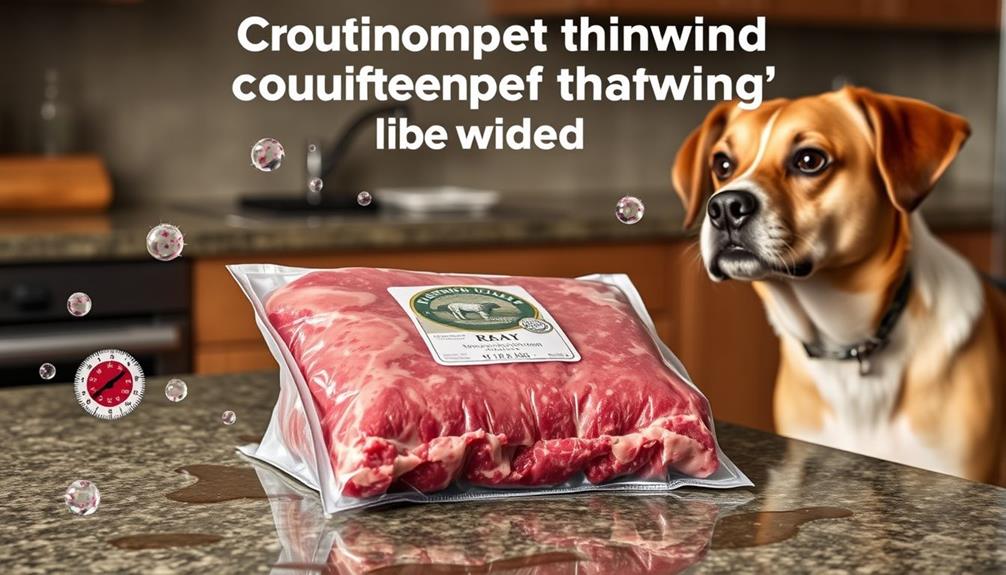
Thawing raw dog food on the countertop may seem convenient, but it poses significant risks to your pet's health. When you use countertop thawing, the outer layer of the meat can defrost while the center remains frozen, creating uneven temperatures. This uneven thawing can lead to dangerous bacteria loads, putting your dog at risk for foodborne illness.
Additionally, it's important to evaluate the potential side effects of improper food handling, similar to the risks associated with cold medications that can affect your pet's well-being.
Evaluate these risks:
- Bacteria thrive in the danger zone of 40-140°F, doubling in number every 20 minutes.
- Leaving raw meat out at room temperature encourages rapid bacterial growth on the surface.
- The USDA recommends not leaving meat out for more than 2 hours to minimize contamination risks.
If you leave raw dog food out for too long, harmful bacteria can proliferate, making it unsafe for your furry friend. Consuming meat that's been thawed this way without proper cooking can lead to serious health issues.
To keep your pet safe, always opt for safer defrosting methods that maintain consistent temperatures and reduce the risk of bacterial contamination. Your dog's health is worth the extra effort!
Cold Water Thawing Technique
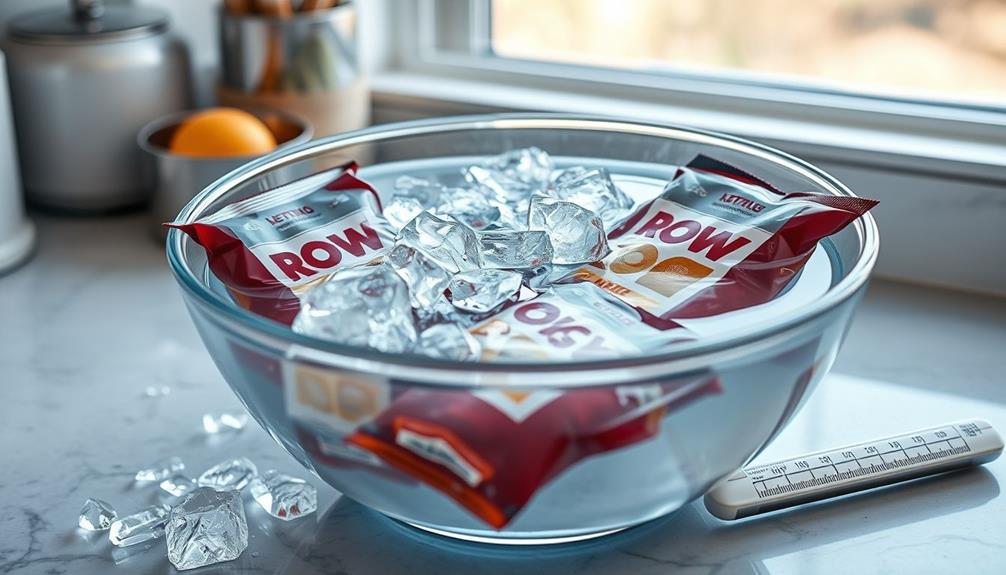
When you use the cold water thawing technique, it's important to prepare properly and keep safety in mind.
Start by sealing the raw food in a leak-proof bag and submerging it in cold water, changing the water every 20-30 minutes.
This method not only guarantees that your dog's food remains safe, but also helps maintain the nutrients, much like the value of budgeting for financial health.
After thawing, make sure to follow best practices to keep your dog's meal safe and nutritious.
Preparation and Safety Tips
The cold water thawing technique is an effective and safe method for defrosting raw dog food quickly. This method isn't only faster than letting the food thaw in the fridge, but it also helps you manage higher bacteria loads by keeping the food at a safe temperature.
Proper disposal habits and understanding safe food handling are essential to avoid contamination, similar to how toilet maintenance practices can prevent plumbing issues.
To guarantee success, follow these preparation and safety tips:
- Always use a leak-proof, waterproof bag to prevent cross-contamination.
- Change the water every 20 minutes to maintain a consistent cold temperature.
- Never use hot water, as it can partially cook the meat and increase bacterial growth.
Thawing Process Steps
A quick and effective way to defrost raw dog food is by using the cold water thawing technique.
Start by placing the raw food in a waterproof bag to prevent contamination. This step is vital to keep things as clean as possible. Additionally, it's important to be aware of how emotional stability can affect daily routines, as seen in individuals with Borderline Personality Disorder (BPD), who may struggle with impulsivity and decision-making.
Next, submerge the sealed bag in a container or sink filled with cold water. Change the water every 20-30 minutes to maintain a safe temperature, guaranteeing your food thaws properly.
This method typically takes a few hours, making it a great alternative to the overnight fridge method if you need to thaw and serve quickly. Remember, never use hot water, as it can partially cook the meat and create unsafe bacteria growth.
Once the raw food is fully thawed using the cold water method, serve it immediately. This guarantees safety and helps maintain its nutrient integrity.
Post-Thawing Best Practices
Following the cold water thawing technique, it's vital to handle the raw dog food with care to guarantee your pet's safety. Incorporating aromatherapy practices, such as using calming essential oils like lavender oil, can create a soothing environment for both you and your pet during mealtime. Adhering to post-thawing best practices will help minimize any risk of bacterial growth after the thawing process.
- Serve the food immediately after thawing.
- Avoid refreezing thawed raw dog food.
- Always wash your hands and surfaces after handling raw food.
Once you've completed the thawing process, serve the raw dog food right away. This step is critical because bacteria can multiply quickly if the food sits out for too long.
Remember, don't refreeze any food that's already been thawed, as this can compromise its safety and quality.
Also, make certain that you wash your hands and any surfaces that came into contact with the raw food. This practice helps prevent cross-contamination and keeps your kitchen safe.
Challenges of Microwaving
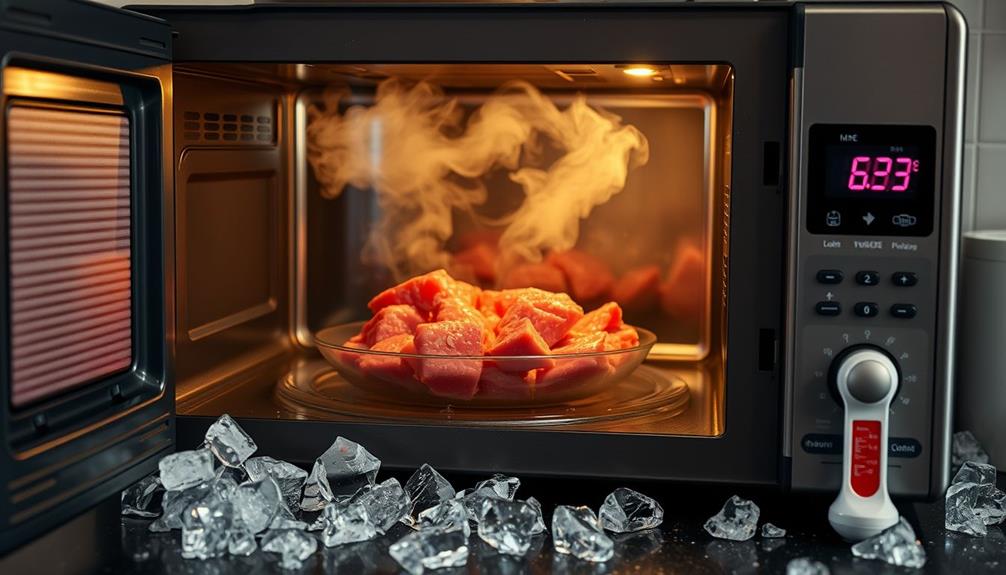
When you microwave raw dog food, you might face inconsistent thawing results, leaving some parts still frozen while others could overcook.
This uneven heating not only risks the nutritional value of the meat but also poses safety concerns for your pet.
Additionally, the high-fat content in certain meats, similar to the ice cream health considerations, can lead to potential health issues if not properly thawed.
It's essential to take into account these challenges before choosing this method for defrosting.
Inconsistent Thawing Results
Microwaving raw dog food often leads to inconsistent thawing results, posing several challenges for pet owners. When you microwave, you might end up with outer layers that are partially cooked while the center remains frozen. This inconsistency can affect both texture and temperature, making it hard to guarantee the food is safe for your pet.
Additionally, employing strategies like mastering the art of bug out bags can enhance your preparedness for various situations, including pet care.
- Uneven thawing can create hot spots that promote bacterial growth.
- Rapid heating of bones may lead to sharp edges, posing choking hazards.
- Nutritional value is compromised when high temperatures denature essential enzymes.
When you're defrosting raw dog food, relying on a microwave can put your pet at risk. As you're trying to maintain a balanced raw feeding routine, you need to prioritize food safety.
Inconsistent thawing not only affects the quality of the meal but also increases the likelihood of foodborne illnesses. Instead of using the microwave, consider safer methods like thawing in the refrigerator or using cold water. These methods help guarantee that your dog's food is both safe and nutritious, allowing you to feel confident in what you're serving.
Risk of Overcooking
Defrosting raw dog food in the microwave can create considerable challenges, particularly the risk of overcooking. When you microwave raw dog food, some sections can cook faster than others, leading to uneven thawing. This inconsistency can cause parts of the food to become overcooked while others remain frozen, compromising the meal's quality.
Additionally, the importance of finding a trusted source for your raw dog food is paramount, especially when considering strong customer service and quality assurance.
Additionally, microwaving bones can create sharp edges, posing choking hazards or risking internal injuries for your pet. High temperatures can also denature essential enzymes, leading to a notable loss of nutritional value. When the outer layers of meat heat up quickly, they can reach unsafe temperatures, increasing bacteria loads in the center where it remains cold. This not only jeopardizes your dog's health but also diminishes the food's overall quality.
Using a microwave for defrosting isn't reliable; it can degrade the nutritional integrity of the raw dog food considerably. Instead, consider safer methods like placing the food in the refrigerator overnight or using a cold water bath. These methods guarantee even thawing, preserve nutritional value, and reduce health risks for your furry friend.
Nutrient Degradation Issues
Using a microwave to thaw raw dog food comes with significant risks, particularly regarding nutrient degradation. While it might seem convenient, this method can compromise the health benefits of your pet's raw diet and pose serious food safety concerns.
High-quality content is essential for pet owners to understand the implications of food preparation methods, as effective keyword research helps identify important queries related to pet nutrition.
- Uneven thawing can leave some portions partially cooked.
- High temperatures can denature necessary enzymes and diminish protein quality.
- Microwaving bones may create sharp edges, posing choking hazards.
When you microwave raw dog food, the heat can destroy essential nutrients that are critical for your dog's health. Nutrient degradation occurs as the food is exposed to high temperatures, which can lead to a loss of important vitamins and minerals.
This is especially concerning if you're committed to providing a balanced raw diet. Additionally, the risk of uneven thawing means that some parts can be unsafe to feed, potentially leading to foodborne illnesses.
Portion Management Tips
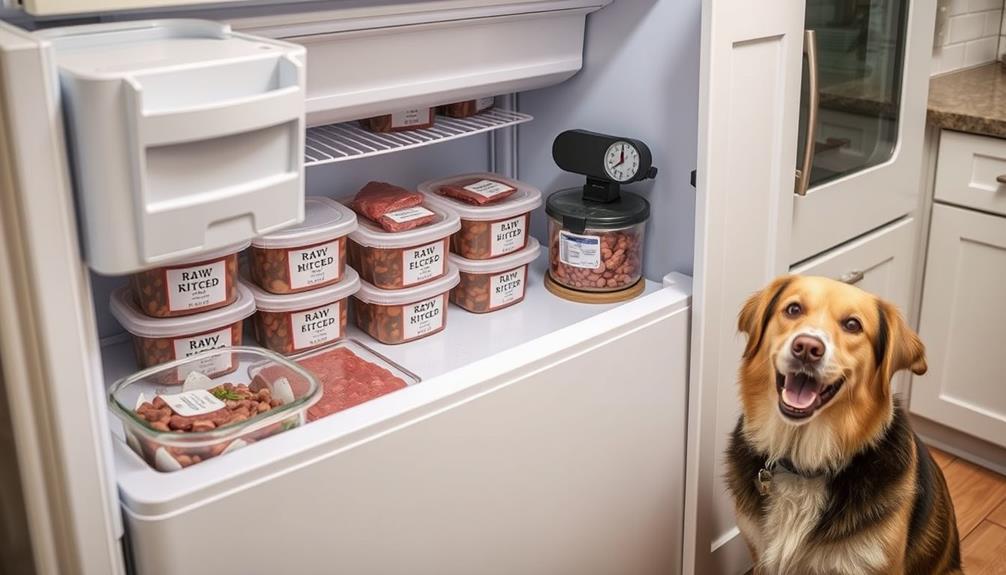
Effective portion management plays an essential role in meeting your dog's nutritional needs. When feeding raw, it's vital to implement portion control to guarantee your furry friend gets the right amount without waste.
Aim to defrost only what your dog can consume within 3-5 days when stored in the fridge. Consider using 500g or 1kg containers for easy serving sizes; a 500g container typically requires 10-12 hours to thaw in the fridge.
If you have unused portions of defrosted raw food, you can safely store them back in the fridge immediately, but make sure they're consumed within 3 days to maintain freshness and safety.
Avoid refreezing defrosted raw food unless it was thawed in the fridge and hasn't been left out for more than 2 hours.
Always check the smell and appearance of the defrosted food before feeding to guarantee it's appetizing and safe. This simple practice helps maintain your dog's health and guarantees that feeding raw remains a positive experience for both of you.
Safe Storage Practices
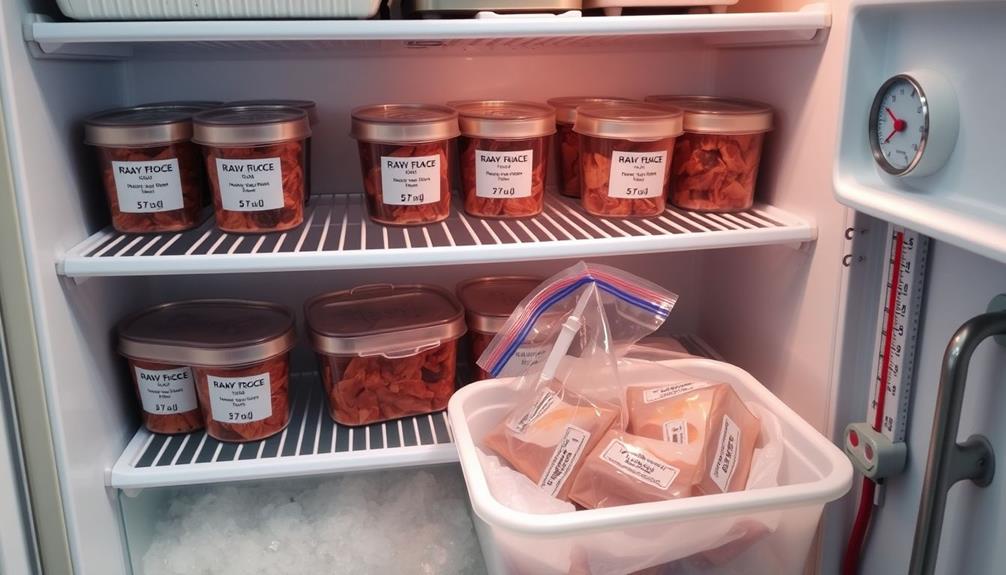
Proper storage of raw dog food is key to maintaining its quality and safety after you've managed your portions. Following safe storage practices will guarantee that your pet's food stays fresh and free from contamination.
- Always use airtight containers to store raw dog food.
- Label containers with defrost dates for easy tracking.
- Keep raw dog food separate from other freezer items.
To maintain the quality and safety of raw dog food, keep your freezer temperature below 0°F (-18°C). This allows you to store it for up to 6-12 months without a decline in quality.
When you're ready to use it, move the food from the freezer to the fridge to thaw, where it can remain fresh for up to 3-5 days.
Remember, after serving, dispose of any uneaten food within 2 hours to reduce the risk of foodborne illnesses in your pet.
Handling Raw Food Safely
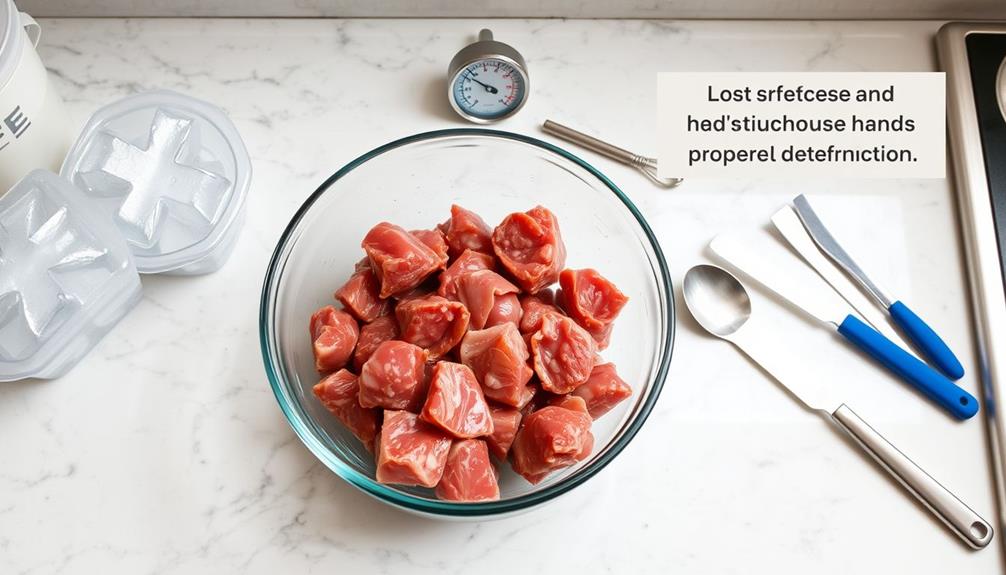
When handling raw dog food, it's essential to use safe thawing methods to prevent harmful bacteria growth.
You should also focus on preventing cross-contamination by using separate utensils and surfaces for preparation.
Proper storage practices, like keeping food in airtight containers, will help maintain freshness and safety for your pet.
Safe Thawing Methods
Thawing raw dog food safely is essential to maintaining your pet's health and preventing foodborne illnesses. Using the right safe thawing methods can make a significant difference. Here are some tips to take into account:
- Thaw in the fridge: This is the safest method, taking 12 to 24 hours while keeping temperatures safe and preserving nutrition.
- Submerge in cold water: For quicker results, place sealed raw dog food in cold water, changing the water every 20-30 minutes. Make sure to feed your pet immediately after thawing.
- Avoid microwaving: Microwaves can cause uneven thawing, potentially cooking parts of the meat and compromising its nutrients.
Never thaw raw dog food at room temperature, as this allows bacteria to thrive in the danger zone between 40°F and 140°F.
Always handle raw food with clean hands and utensils. After preparation, sanitize surfaces to maintain a hygienic environment.
Cross-Contamination Prevention
Handling raw dog food safely is imperative to preventing cross-contamination and protecting both your pet's health and your family's well-being.
Always wash your hands thoroughly before and after handling raw dog food to avoid transferring harmful bacteria loads to other surfaces or food items. It's essential to use separate utensils and cutting boards exclusively for raw meat. This practice helps you minimize cross-contamination with other food, ensuring that your meals remain safe for everyone at home.
After thawing raw dog food, store it in airtight containers and label them with defrost dates. This way, you can track freshness and prevent mix-ups with other items in your fridge.
Clean and disinfect all surfaces that come into contact with raw dog food immediately after use. This step is critical in eliminating any lingering bacteria that could pose risks.
Proper Storage Practices
Proper storage practices are essential for maintaining the quality and safety of raw dog food. To keep your pet's meals fresh and bacteria-free, follow these key tips:
- Store raw dog food in airtight containers.
- Label containers with defrost dates.
- Keep raw dog food in a dedicated freezer.
When you receive raw dog food, place it in the fridge immediately for ideal freshness. If you're using a freezer, make sure it's set to below 0°F (-18°C) to prevent spoilage.
Properly stored, raw dog food can last 6-12 months, so you won't have to worry about frequent replacements.
Keep in mind that refreezing defrosted raw dog food isn't recommended unless it was thawed in the fridge and hasn't been left at room temperature for more than 2 hours.
Always wash your hands and sanitize surfaces before and after handling raw dog food. This minimizes the risk of cross-contamination and bacteria growth, safeguarding your dog's health and safety.
Monitoring Your Pet's Health
Keeping a close eye on your pet's health is essential, especially when shifting them to a raw food diet. Regular vet check-ups are vital for monitoring your dog's overall health and guaranteeing their dietary needs are met effectively.
You should maintain a log of your dog's feeding habits and any adverse reactions to help you adjust their diet based on age, weight, and activity level.
Observing your pet for signs of digestive issues is key. Look for changes in stool consistency or appetite, which may indicate potential dietary problems.
It's also important to monitor your dog's energy levels and behavior after meals. A positive response to their raw food diet is a good sign that you're on the right track.
If you notice any significant changes in your dog's health, weight, or behavior, don't hesitate to consult with a veterinarian. Addressing possible dietary deficiencies or health concerns early can make a big difference in your pet's well-being.
Alternatives When Out of Food
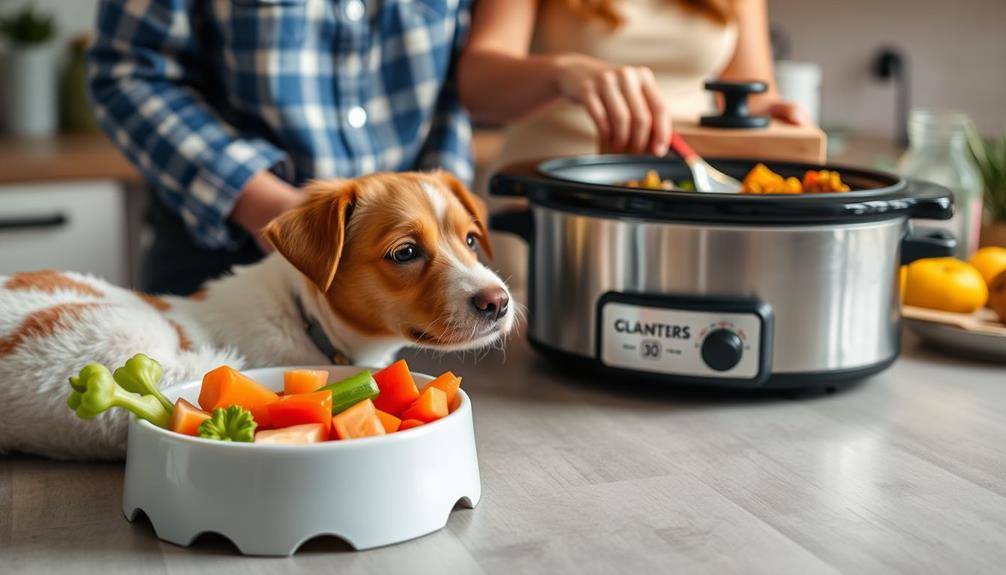
Monitoring your dog's health while on a raw food diet is important, but what happens when you find yourself out of their usual food? There are a few high-quality alternatives you can consider to guarantee your furry friend stays healthy and satisfied.
- High-quality dry dog food: Brands like Wolfworthy provide balanced nutrition that can serve as an effective temporary alternative.
- Freeze-dried or dehydrated raw food: Keep these on hand; they can be prepared quickly in under ten minutes and serve as a convenient backup.
- Premium wet dog food: A few cans can be a great emergency option, but always check that it meets your dog's dietary needs.
If you're in a pinch, you might even consider temporarily fasting your dog for a day, as dogs can usually go without food for a short period without health risks.
Always make certain that any alternative food you choose meets your dog's nutritional needs. If you're ever unsure, consult with your veterinarian to guarantee your backup plan supports your pet's health and well-being.
Customer Feedback and Experiences
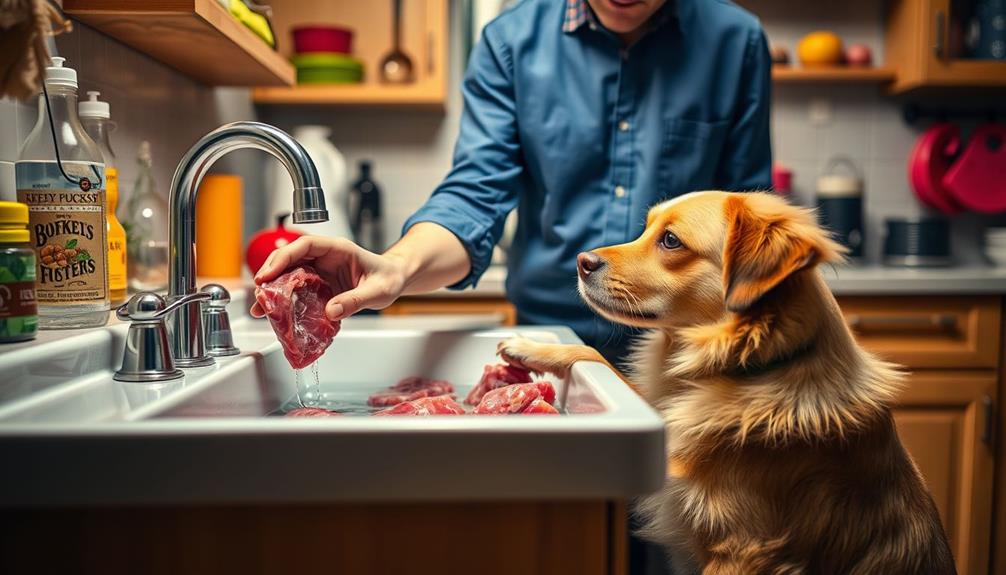
Many dog owners rave about their experiences with Grand Dog Essentials, often highlighting how the quality and taste of the raw dog food have positively impacted their pets' health. With an impressive 4.8 out of 5 rating based on 249 reviews, customer feedback showcases satisfaction with the product's quality and convenience.
Many users appreciate the easy-to-follow defrosting methods, which help guarantee their dogs receive safe and nutritious meals. Testimonials frequently mention how proper defrosting and handling of raw food have led to noticeable improvements in their dogs' overall health.
Customers also emphasize the importance of educating all household members on safe thawing practices, contributing to a consistent feeding routine. This education not only maximizes the benefits of raw dog food but also fosters a sense of confidence among pet owners.
Additionally, customers value the availability of high-quality alternatives to raw food, making it easier to maintain balanced nutrition for their pets even when raw food isn't on hand.
Frequently Asked Questions
How Do I Defrost My Dog's Raw Food?
To defrost your dog's raw food, place it in the fridge overnight for safe thawing. If you're in a hurry, submerge it in cold water, changing the water regularly to keep it safe.
The benefits of raw dog food include improved digestion, healthier skin and coat, and increased energy levels. It’s important to handle raw dog food safely to prevent any contamination. Once the food is thawed, be sure to serve it to your dog promptly and discard any leftovers to avoid any potential health risks. The proper handling of raw dog food ensures that your pet can enjoy its numerous benefits while staying safe and healthy.
Can You Defrost Raw Dog Food on the Counter?
You shouldn't defrost raw dog food on the counter. Bacteria thrive in the danger zone, risking your pet's health. Instead, use the refrigerator or cold water methods to guarantee safe and proper defrosting.
What if I Forgot to Defrost Raw Dog Food in the Fridge?
Oh, the classic "I forgot" moment strikes again! Don't panic; just grab a waterproof bag, submerge it in cold water, and change that water every 20 minutes. Your pup's dinner doesn't have to be a disaster!
How to Quickly Thaw Just Food for Dogs?
To quickly thaw food for your dog, place it in a waterproof bag and submerge it in cold water. Change the water every 20-30 minutes, ensuring it's ready within a few hours for serving.
Conclusion
In summary, defrosting your dog's raw food properly is essential for their health and safety. Did you know that nearly 80% of pet owners who improperly thaw raw food report health issues in their pets? By using cold water or the fridge method, you can minimize risks and guarantee your furry friend enjoys a nutritious meal. Remember to manage portions and handle raw food safely to keep your pet happy and healthy!

